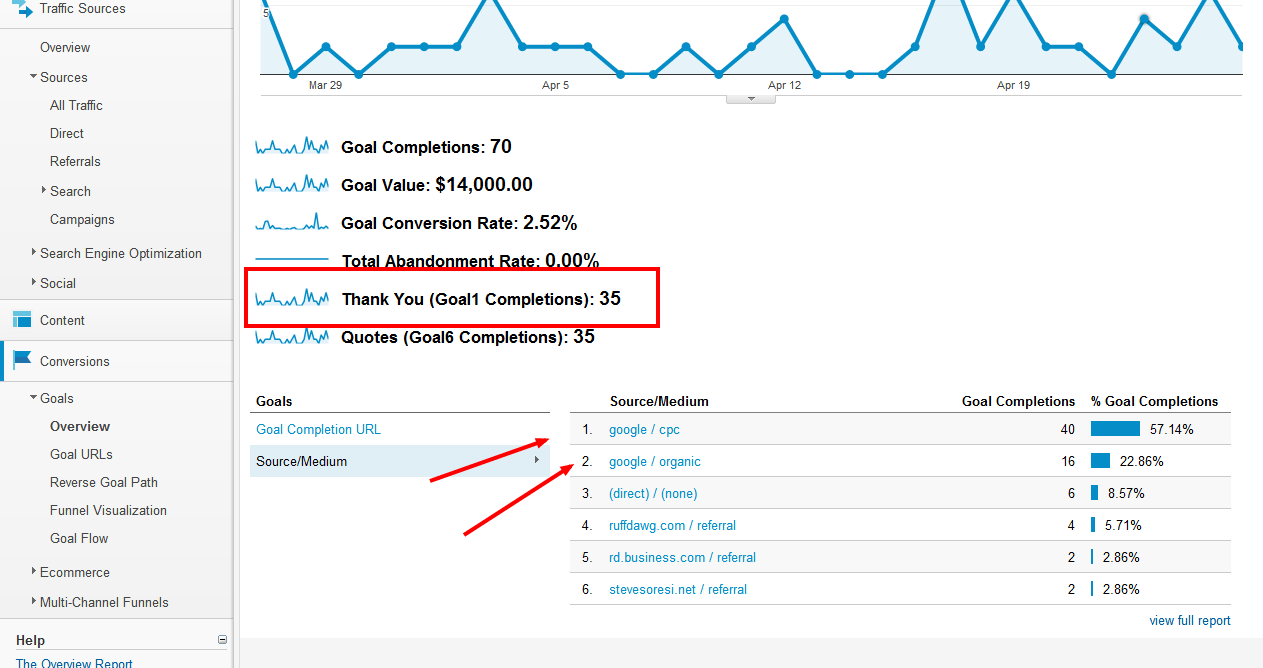How Many Web Visitors Does It Take to Screw in a Light Bulb?
Conversion Rate for Custom Manufacturers? Do You Know Yours?
Would You Pay $6,000 to book an order? What does it cost to generate a quote?
As a Search Engine Optimization and Internet Marketing firm, I deal almost exclusively with custom manufacturing companies. My clients generally do not manufacture standard products but instead offer a custom item or service. They include wire forming, plastic molding, electron beam welding, thermoforming, cable assemblies, thermal spray coating etc. Ya know, exciting stuff. I work with these firms to increase traffic of course, but in the end, we are trying to generate quality RFQ’s that convert into orders. So my job, essentially, is to provide a steady stream of inquiries.
So I need to do two things. Drive qualified traffic that will in turn produce Requests for Quote. So how many visitors, on average, would you expect it take to generate one single RFQ and how do we measure this?
Industry Averages
You may have seen quotes figures that an average conversion rate ( number of visitors divided by “goal”, in that case our goal is an RFQ) is 2 to 4% and many sites claiming an overall average of 2.3%. This is mainly geared towards large ecommerce sites with the goal of selling a product. I have yet to see any study by any group or Industry that has nailed down a Conversion rate for custom suppliers or even Industrial companies. In our case, our goal is measure by (total visitors divided by Rfq’s). I can tell you that the average conversion rate I see across all these companies is in the 1% range. So for every 100 visitors we will see ONE quote. Now I cannot state that this is a good number or a bad number, but it seems to be very consistent across all of my clients. Keep in mind that I am measuring online activity only. It does not include phone inquiries. My estimate is that if you include VALID NEW INQUIRES via the telephone, RFQ Conversion rate may double to about 2%, but this is conjecture on my part gleamed from asking many of my clients. Although we have tracked phone calls via tracking numbers, recording calls etc, it is very difficult to determine a new inquiry from a new client while filtering out nuisance inquiries (unqualified calls, prospecting, inventors, wrong service etc.) So we are left with assuming an AVERAGE Conversion rate for RFQ’s at 1 to 2%.
How Do I Measure MY Conversion Rate?
So how do you determine a conversion rate for your site? It is actually fairly easy. Assuming you have a simple Contact Form on your site, you should be serving up an acknowledgment page such as “Thank you for your Inquiry. We will Respond shortly” or “Message Sent” (see screen capture). This page will have a unique RFQ such as www.abc.com/thank-you. This page is only displayed if someone fills out and sends an Inquiry. Your analytics program will tell you how many times this page has been displayed (and with some deeper delving where they came from). So if your site received 1,000 visitors and your thank you page was displayed 10 times, your online conversion rate is 1%. You could also keep a log of phone calls if you are a small company or investigate call tracking solutions. Some are very advanced and can serve up different phone numbers for different keywords, but most are overkill for small and medium sized manufacturers. Keep a log for two months and you will know all you need to know.
What affects Conversion Rates?
There are several key factors that will affect your conversion rate:
Quality of your traffic – You cannot convert the WRONG visitor or an UNQUALIFIED prospect
Quality of Your Site – If your website is confusing or thin on technical content, visitors will leave quickly.
Calls to Action – If you make it difficult to find contact info, prospects will give up. Or if you have long cumbersome forms, very few ill have the patience to complete. Sometimes even finding a simple phone number or email on a site is a tedious and confusing task. Make the visitors experience easy and pleasant or he is gone to your competitor.
What Does All this Mean?
If you are like most Industrial suppliers today, you are trying to increase sales and use the web as part of that strategy. So if you are spending money to gain traffic and quotes, how do you measure success. Well obviously the first line is to benchmark how many RFQ’s you are receiving. And now let’s take a look at what your Internet marketing investment might be costing you and attempt to assign an ROI on that spend.
Let’s say you are spending $1000 a month on Google Adwords. These keywords are generating 250 visits a month ($4 per click). You check your analytics and see that you received 4 quotes from these visits. So your cost for each quote as $250.
It is more difficult to measure your actual close ratio for your online quotes. If you are like most custom suppliers, it may be months or even over a year before your quote turns into a sample or prototype and finally ramps up to production mode. But for the sake of argument, let’s assume you achieve a closing ratio of 5%. What did that order cost you from your online efforts for one year?
Costs for Pay Per Click Google Adwords Program $12,000
Total RFQ’s Generated 48
Cost per RFQ $250
Total Order Closed at 4% Close Ratio 2
Online Marketing Cost per Order $6,000
While spending $6,000 to book an order may seem crazy to some firms, if you are a custom manufacturer and received a commitment on a $100,000 project, it generates phenomenal ROI. Most of my clients are like the Marines, where they are only looking for a few good men. One or two orders per year may be huge to their success. It is far different from a Company selling a $100 widget at a 15% gross margin.
Your percentages may be very different than those above. They key is to measure the activity and conversions on your website and other initiatives
What Should You Know. What Can You Do?
Below are 7 Important Steps to Take to Measure Your ROI
1 – Insure you have a good Analytics program installed. Google Analytics is free and easy to install and will provide you with all the basic information of how your site is performing. If you are unsure how to interpret the numbers, get some help.
2 – Set up a “thank- you “ or acknowledgement page for all your contact forms on your site.
3 – Set up a “Goal” in Google Analytics. In this case the “Goal” would be when a visitor fills out the Contact form and receives a “thank-you” page. This will give you an easy way to measure how many quotes you received over a given point of time. You could also set up parameters to determine where these visitors are coming from.
4 – Determine which “segments” of your traffic are most effective. You can break your traffic into segments or groups such as Organic Search, Pay-per-click, Referral traffic from Directories such as ThomasNet, Global Spec, Business.com, Industry specific sites etc. This way you can determine which sources of traffic are leading to Contact, Quotes, etc. This new Visualization Flow from Google Analytics helps you “see” where traffic that goes to the “Contact Us” page originates from.
5 – Once you have this information, work up a simple ROI chart to establish your most effective marketing.
Source # of Quotes Cost $/ Quote Close% Cost/Order
Google Organic 60 ?
Google PPC 48 $12,000 $250
MFG.com 60 $7,000 $116
Thomasnet 36 $9,000 $250
Global Spec 24 $15,000 $625
Zycon 12 $1200 $100
Sample data only. Results may differ radically.
Obviously it is a challenge to get a precise ROI. For most custom manufacturers the value of each individual order will also vary widely. Also, one customer may result in repeat business for many years further skewing these numbers. At least you can start with some basic metrics to establish a baseline of RFQ’s being generated by each segment of traffic.
6 – Set up a simple system to measure phone calls. While I have never seen specific published data, I believe up to half of all inquiries may come from phone calls. You have many options here depending in the size of your organization. If you record and log all quotes now, you could add the date and time and try to ascertain where online they found you before calling. The problem with asking the prospect is they often do not remember the exact search that led them to you. They may have started with Google, went to a Directory and found you there. Yet they may claim they found you on Google. You could set up a unique 800 tracking number on the website for a few months to help measure as well.
7-If you are unsure how to set these up and lack internal resources, find some help. You are probably investing a significant amount of time generating quotes as well as the resources to respond to those inquiries. Make sure your dollars are being spent wisely.
Conclusion
Everything action on your website is measurable. And you probably have a general idea of overall traffic, best keywords, most popular pages and largest referrers. But do you know what is leading to the most quotes and the largest orders? Where should you invest your money going forward? Are directories still effective and providing the right visitors. Are online marketplaces more effective than doing Pay-Per-Click with Google? Should you spend money on optimizing your site and generating more organic traffic?
All of these questions can be answered to some extent, depending on how deep you want to dig. Make no mistake, it is a challenge for custom manufacturers to track EXACTLEY where an order originated. But is it fairly simple to establish a baseline of what is most effective generating quotes and what is a waste of time and money and a drain on precious resources. Stop guessing and start measuring.



What is the average online conversion rate for custom manufacturers?…
I have recently written a blog post adressing conversion rates for manufacturers after analyzing client data and discussions with other marketers. It can be found here http://www.agileinternetmarketing.com/2012/latest-marketing-trends-from-agile/…